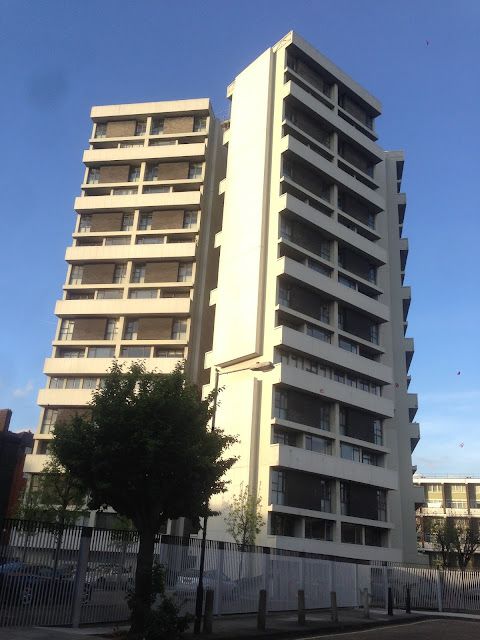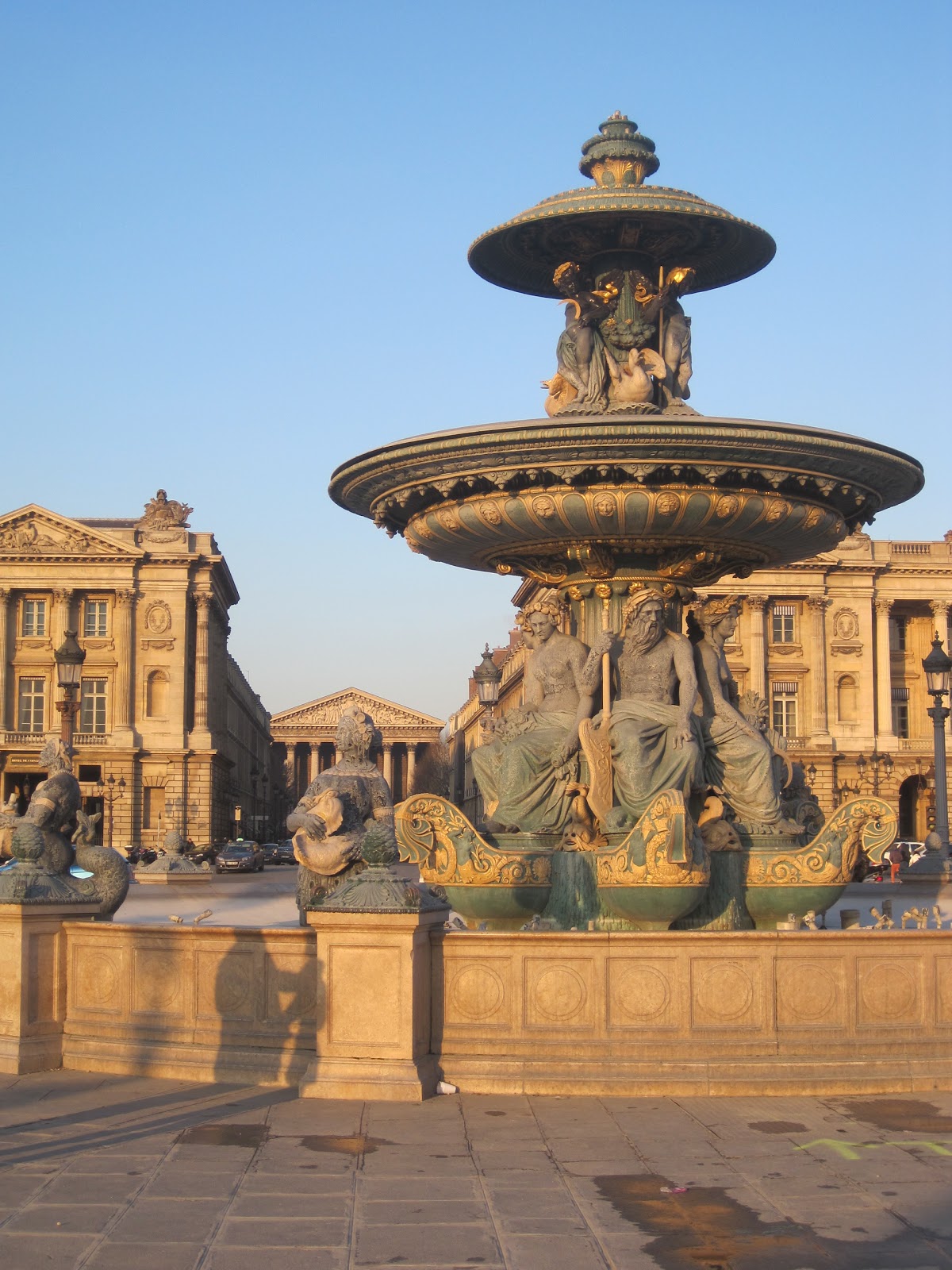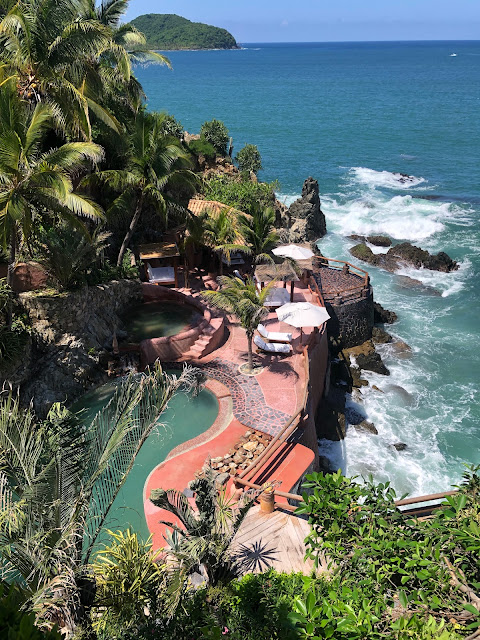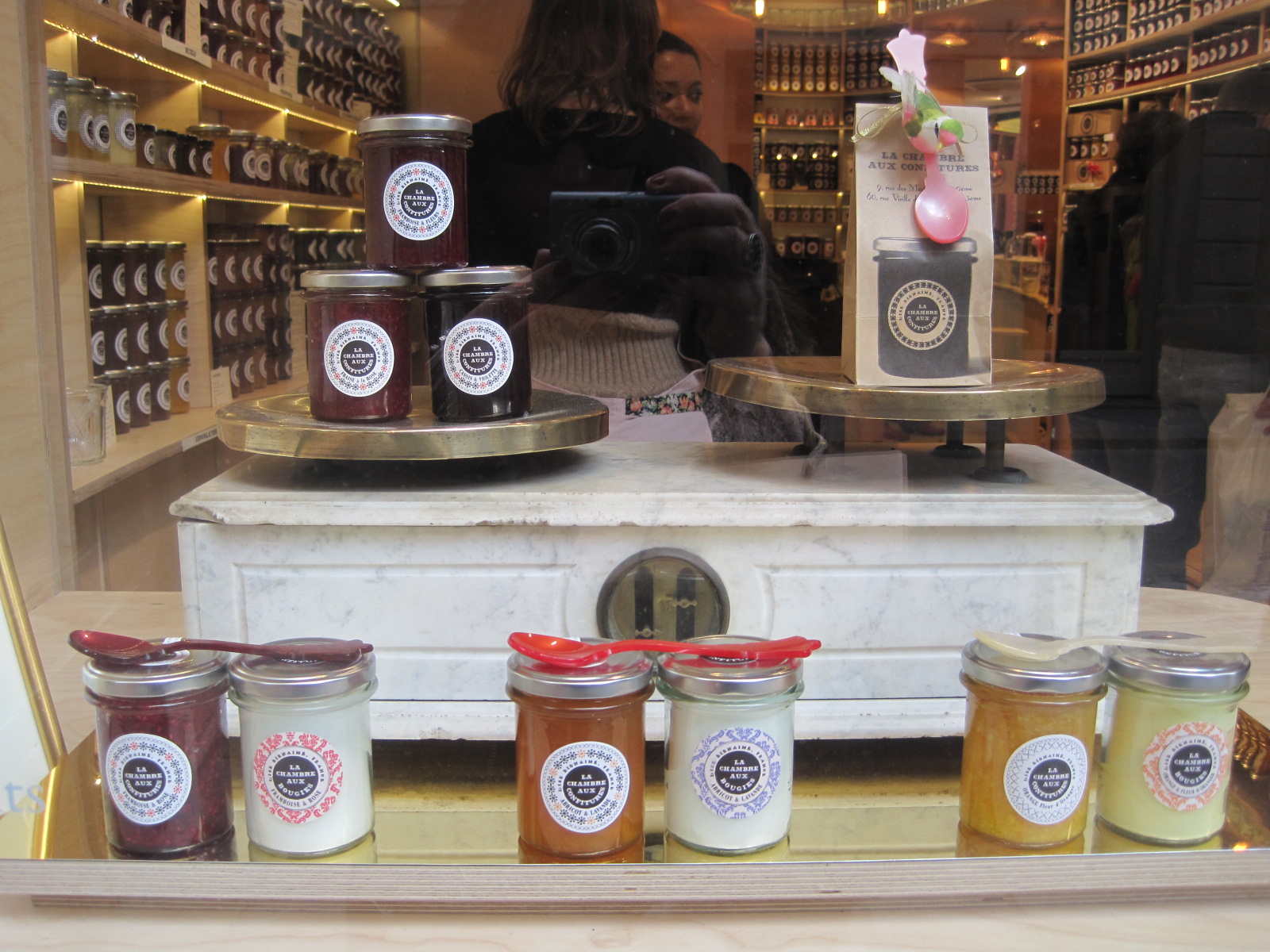Four Examples of London's Modernist Social Housing
I. Keeling House We didn't have to go far to explore London's modernist social housing as we spent three months staying in Denys Lasdun's Keeling House in Bethnal Green. The innovative tri-partite tower block (which you can see above) was built for, and opened to, council tenants in 1957. Lasdun is of course known primarily as the architect of the iconic National Theatre building on the Thames - which remains a notable example of Brutalist architecture in London, see below. Brutalism doesn't seem to get much love, but D. and I both appreciate the clean modern lines of the "raw concrete" or "beton brut" the French word from which the term "Brutalist" derives.
Now a Grade II listed building, Keeling House was Lasdun's attempt to address the functional needs of working class housing tenants in post-war London. His maisonette design echoed the two story terraces that the occupants left behind them. He designed the building to provide spaces for hanging out washing along with communal areas for people to socialize. I have to say we found it a delightful place to stay. The flats have dual aspects, small balconies and lots of light. They were refurbished in the 1990's after the building was converted to market rate flats and an extensive renovation was undertaken by a private developer.
Perhaps because we were staying at Keeling House we were interested in the development and transformation of social housing in London after the war. Or perhaps it was because the Conservative government was on the television and in the papers in the weeks leading up to the May 2015 elections promising to allow even more council tenants to buy their flats in another round of privatizations. Bethnal Green is hardly glamorous, but it is changing quickly and the transformation of social housing stock is integral to this process. As flats are sold into the private market the demographic face of the neighborhoods will change and I'm sure in five to ten years there will be far fewer immigrant families in the area.
II) The Golden Estate (above) was built right before, and right next to the Barbican site which was subsequently developed by the same architectural practice. There's just something fascinating about these planned communities that speaks to a hope for a better future and a shared responsibility for essentials like housing. While the hopes for social housing may have stumbled in the face of enduring social problems caused by poverty, its hard to imagine today that the government could commit itself to such a radical social transformation.
In the late 1970's and 1980's the high-rise was stigmatized as a non-functional, socially alienating architectural form and a number of social housing projects were demolished or (like Keeling House) sold into the private sector. In many cases there were issues with maintenance as the buildings which had been poorly constructed. However, the high-rise itself is now highly desirable, it wasn't the the architectural form that was the issue, but the social problems that were located in these buildings, for example the concentration of unemployment and marginalization in the resident population.
III) The Barbican is the largest and probably to best know of the post-war housing developments in London and I've blogged about it here. It's very much a Brutalist design but the concrete gives it a solidity that appeals to me. It's large, quiet inwards looking and has it's own school, arts complex, and large private conservatory. There are wonderful pubic spaces reserved for residents. This is another place that started as social housing but is now predominantly in the private sector with flats changing hands at prices well beyond a million dollars. This gives you an idea of the wide concrete walkways that span the complex.
One of the things I love about London are the contrast and St Giles Cripplegate which stands in the middle of the Barbican is a reminder of the city erased in the Blitz. The church has the following quote from A.N. Wilson on their website and its worth sharing here too, "The Barbican now an immense plate glass fantasy, enormous towers soaring up to the sky. But doggedly, in the middle of it all, St Giles' Cripplegate, bombed, repaired, stands as the last imaginable little memorial of a vanished city that Shakespeare knew."
IV) Bevin Court in Islington was designed by Berthold Lubetkin and was completed in 1954. Built on the site of a former residence of the Russian exile Lenin (1902-3) the housing development was initially to be names Lenin Court. The name was modified after the Second World War when alliances shifted and Russia fell out of political favor. Instead it was named after the trade unionist and politician Ernest Bevin, who served as both Minister of Labour during the wartime coalition and as Foreign Minister in the post-war Labour government. A bust of Lenin, which remained at the site, proved a focus for conflict between fascists and leftists and was eventually removed too, erasing the connection entirely. It is apparently a myth that the bust is buried below the staircase. Apparently the flats were among the first social housing to provide windows on both sides of the building . This dual aspect of course makes the flats brighter and more livable.
We wandered in here on an Islington walking tour that took us to several of Lenin's old haunts and were lucky enough to meet someone who brought us in to see the refurbishment. It is well worth visiting to see the magnificent Lubetkin staircase which has recently been restored, as you can see above.
Visiting these four different examples of post-war council housing raised a series of questions, but the central one seemed to be what are our societal obligation in London and elsewhere? With the current explosion of nonresident buyers and prices rising exponentially, what will London look like in twenty years? Should you have the right to live where you were raised? Is housing nothing more than a market driven commodity or should we be creating and subsidizing housing for "regular" Londoners?
We were baffled by what constitutes social housing, I presumed it was the council housing of my youth, subsidized and relatively cheap, truly affordable for those on smaller incomes. We were astonished to discover that in the UK the government's definition of "affordable" housing is housing built by developers as part of a larger project and priced at 80% of the market rate. Given current housing costs in London, this is far in excess of what even middle class families would find accessible.
The question of how developers circumvent their legal obligations to provide government mandated "affordable" housing goals was superbly laid out in a lecture we went to at the Bishopsgate Institute. You can hear the full critique by Oliver Wainwright, the architecture and design critic of the Guardian, in a podcast here . So, while there is very little government run council/ social housing like the modernist buildings above being built today, the waiting lists remain very large. In Tower Hamlets the council district where we lived the 22,000 people remain on the waiting list for social housing according to the local MP who was recently quoted in the Economist.


















Comments